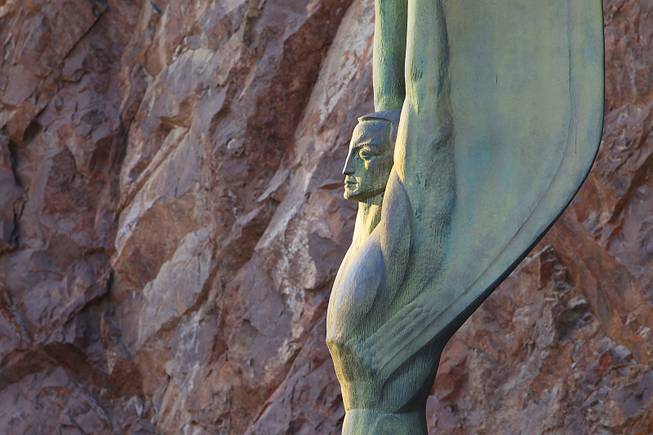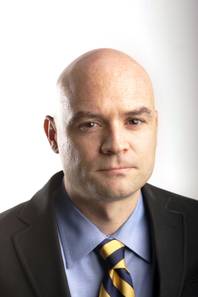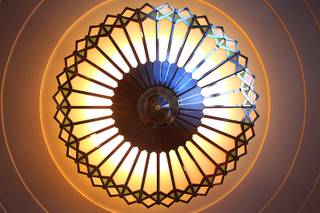
Sam Morris / Las Vegas Sun
Winged Figures of the Republic is seen at the Hoover Dam Wednesday, March 7, 2012.
Friday, March 9, 2012 | 2 a.m.

J. Patrick Coolican
Sun archives
What I like most about the Smith Center for the Performing Arts is that it’s ours.
By that I mean it’s a cultural space for locals, but I also mean it’s an institution made possible by a homegrown, collective vision, organization and effort.
When a new megaresort opened on the Strip, that was sometimes a source of pride — Las Vegas continues to grow with ever more extravagant and spectacular casino hotels and attractions. And many among us helped build them or worked in them once they were completed.
But let’s not kid ourselves. The Strip isn’t really ours. Those resorts were the vision of a few moguls, and the profits flow to shareholders and bondholders.
As for our public structures? With a few exceptions, our schools and government buildings were often haphazardly thrown up — sometimes resembling low-slung military barracks — and illustrated our indifference to the public square.
The Smith Center, however, makes two bold statements: The first is that we’re building a community that is solid, not ephemeral. Contrary to a strangely common sentiment, yes, Las Vegas will be here in 50 years, and the Smith Center is proof.
The Smith Center, funded by a public-private partnership, also says that we are a community marching, with the tail winds of collaboration and passion at our back, toward a shared progress.
With these two statements in mind, Smith Center architect David Schwarz’s homage to Hoover Dam is significant.
Schwarz said he struggled to capture and respect Las Vegas and its history because we obviously have a conflicted attitude about our past: We often demolish it to make way for the new.
He seems to have realized that any nod to our destroyed hotels, or to any of the themes of the Strip, would have been banal and insulting and might have become quickly dated.
The Hoover Dam, however, is our origin story, a conquest of order over chaos. Without it, without the collective vision, organization and effort that built it, there would be no Las Vegas, no American Southwest as we know it.
I went down to the dam this week to remind myself of the achievement. The dam, completed after just four years of construction, is 3.25 million cubic yards of concrete. It provides water for our valley, Phoenix and 33 other communities in Southern California. It helps irrigate crops that provide California fruits and vegetables to the nation year round. It provides clean electricity for 1.3 million people.
What would Tea Partyers say to the idea now? That it was a “government boondoggle” and amounted to government “picking winners and losers”? By the same token, would modern environmentalists have allowed it?
During that time of American striving, it wasn’t enough that the government would build a dam that would “make the desert bloom,” as the memorial to its dead workers says.
The dam also had to be a symbol of national greatness, which meant it had to be a thing of beauty. And so the Bureau of Reclamation brought in architect Gordon B. Kaufmann and artist Allen True. As Julian Rhinehart writes, Kaufmann simplified the design of the dam, making it more elegant, while True provided its striking ornamentation, such as the Southwestern Indian designs in the terrazzo floors.
Finally, Oskar J.W. Hansen’s “Winged Figures of the Republic,” the soaring but seated sculptures, express a human aspiration for greatness.
These elements combine to make the dam a great icon of the Art Deco era, which used symmetry and modern materials to give a sense of human achievement.
Schwarz, who was in a suit and sandals during a recent media day, seems like a jaunty fellow. He took the art deco of the Hoover Dam and added a heaping bowl of modern Vegas, the Vegas that does everything over-the-top. And so there aren’t art deco touches. It’s art deco obsession. Down to the trash cans in the restrooms, fixtures, door handles, chandeliers. I suspect there’s a wink-and-nod aspect to the whole thing, which means Schwarz gets the city.
Benjamin Victor’s sculpture at the center of the grand lobby is original but also a tribute to the dam’s “Winged Figures” and makes the connection explicit.
I don’t know anything about architecture or design, so call me a philistine and tell me I’m out of my depth, but as I walked around the Smith Center, and especially the main performance space, I was happy to be alive at this moment in Las Vegas because of what we’re telling the world, and ourselves.
And the music hasn’t even started yet.


Join the Discussion:
Check this out for a full explanation of our conversion to the LiveFyre commenting system and instructions on how to sign up for an account.
Full comments policy